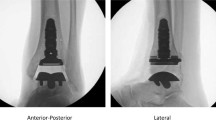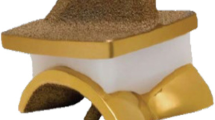Abstract
Metals, ceramics, and polymers are commonly used as orthopedic implant materials. Conventionally, Cobalt Chromium (CoCr) alloys, Titanium (Ti) alloys, Alumina (Al2O3) ceramic, Hydroxyapatite (HA), and Polyetheretherketone (PEEK) are used. Bone resorption owing to stress shielding is one of the reasons for the failure of total ankle replacement (TAR). The stiffness mismatch between the tibia bone and the implant is responsible for stress shielding. It is hypothesized that stress shielding can be reduced by tailoring the implant material similar to the tibia bone by using functionally graded materials (FGMs). The aim of the study is to understand the effect of FGMs on the stress shielding of the tibia bone for TAR. Finite element (FE) models were prepared for, the natural bone, and the implanted bone with the tibial component made from CoCr alloy, Ti alloy, Al2O3 ceramic, FGM of Al2O3 ceramic at the bottom and PEEK at the top, and FGM of Ti at the bottom and HA at the top. Material properties for FGMs were assigned using Ansys APDL code. The results indicated that the highest stress shielding was present in the Al2O3 ceramic model. Whereas, the least stress shielding was in the Ti + HA FGM model. This implies that the stress shielding and subsequently the bone resorption can be reduced by using the FGMs. Thus, FGMs are advantageous when compared to conventional implant materials in order to reduce stress shielding.




Similar content being viewed by others
References
Nag, S., Banerjee, R.: Fundamentals of Medical Implant Materials. In: ASM Handbook, Materials and Medical Devices, vol. 23, (2012)
Huiskes, R., Weinans, H., Van Rietbergen, B.: The relationship between stress shielding and bone resorption around total hip stems and the effects of flexible materials. Clin. Orthop. Relat. Res. 274, 124–134 (1992). https://doi.org/10.1097/00003086-199201000-00014
Shepherd, D.E.T., Dearn, K.D.: Wear Processes in Polymer Implants. In: Durability and Reliability of Medical Polymers, pp. 143–163 (2012). https://doi.org/10.1533/9780857096517.2.143
Ma, H., et al.: PEEK (Polyether-ether-ketone) and its composite materials in orthopedic implantation. Arab. J. Chem. 14(3), 102977 (2021). https://doi.org/10.1016/j.arabjc.2020.102977
Sola, A., Bellucci, D., Cannillo, V.: Functionally graded materials for orthopedic applications – An update on design and manufacturing. Biotechnol. Adv. 34(5), 504–531 (2016). https://doi.org/10.1016/j.biotechadv.2015.12.013
Mondal, S., Ghosh, R.: Influence of cancellous bone material and dead zone on stress-strain, bone stimulus and bone remodelling around the Tibia for total ankle replacement. Proc. Inst. Mech. Eng. Part H J. Eng. Med. 235(2) (2020). https://doi.org/10.1177/0954411920967775
Huiskes, R., Weinans, H., Grootenboer, H.J., Dalstra, M., Fudala, B., Slooff, T.J.: Adaptive bone-remodeling theory applied to prosthetic-design analysis. J. Biomech. 20(11–12), 1135–1150 (1987). https://doi.org/10.1016/0021-9290(87)90030-3
Hedia, H.S., Shabara, M.A.N., Fouda, N.: A method of material optimization of cementless stem through functionally graded material. Int. J. Mech. Mater. Des. 1, 329–346 (2004). https://doi.org/10.1007/s10999-005-3307-4
Rodrigues, D.S.de.O.S.: Biomechanics of the total ankle arthroplasty : Stress analysis and bone remodeling, Master’s thesis, Instituto Superior Técnico, Técnico Lisboa (2013)
Moussa, A.A., Yadav, R.: Optimization of a functionally graded material stem in the femoral component of a cemented hip arthroplasty: influence of dimensionality of FGM. Hindawi J. Med. Eng. 2017, 3069351 (2017). https://doi.org/10.1155/2017/3069351
Oshkour, A.A., Osman, N.A.A., Yau, Y.H., Tarlochan, F., Abas, W.A.B.W.: Design of new Generation femoral prostheses using functionally graded materials: A finite element analysis. Proc. Inst. Mech. Eng. Part H J. Eng. Med. 227(1), 3–17 (2013). https://doi.org/10.1177/0954411912459421
Oshkour, A.A., Talebi, H., Seyed Shirazi, S.F., Yau, Y.H., Tarlochan, F., Abu Osman, N.A.: Effect of geometrical parameters on the performance of longitudinal functionally graded femoral prostheses. Artif. Organs 39(2), 156–164 (2015). https://doi.org/10.1111/aor.12315
Ayatollahi, M.R., Davari, M.H., Shirazi, H.A.: To improve total knee prostheses performance using three-phase ceramic-based functionally graded biomaterials mechanical requirements of. Front. Mater. 6(May), 1–9 (2019). https://doi.org/10.3389/fmats.2019.00107
Enab, T.A.: A comparative study of the performance of metallic and FGM tibia tray components in total knee replacement joints. Comput. Mater. Sci. 53(1), 94–100 (2012). https://doi.org/10.1016/j.commatsci.2011.09.032
Bahraminasab, M., Sahari, B.B., Edwards, K.L., Farahmand, F., Hong, T.S., Naghibi, H.: Material tailoring of the femoral component in a total knee replacement to reduce the problem of aseptic loosening. Mater. Des. 52, 441–451 (2013). https://doi.org/10.1016/j.matdes.2013.05.066
Jyoti, S., Mondal, Ghosh, R. Biomechanical analysis of three popular tibial designs for TAR with different implant-bone interfacial conditions and bone qualities: A finite element study. Med. Eng. Phys. 104(December 2021), 103812 (2022). https://doi.org/10.1016/j.medengphy.2022.103812
Terrier, A., Larrea, X., Guerdat, J., Crevoisier, X.: Development and experimental validation of a finite element model of total ankle replacement. J. Biomech. 47(3), 742–745 (2014). https://doi.org/10.1016/j.jbiomech.2013.12.022
Acknowledgements
The authors would like to thank the Indian Institute of Technology Mandi for proving the computation resources for this research and for supporting this work.
Funding
This research did not receive any specific grant from funding agencies in the public, commercial, or not-for-profit sectors.
Author information
Authors and Affiliations
Contributions
Jyoti: Conceptualization, Visualization, Formal analysis, Investigation, Methodology, Software, Validation, and Writing-Original Draft. Rajesh Ghosh: Conceptualization, Visualization, Investigation, Resources, Supervision, Writing-Review and Editing. Both authors discussed the results and suggestions mentioned in the manuscript at all steps and have approved the final article.
Corresponding author
Ethics declarations
Conflict of interest
The authors declare that they have no known competing financial interests or personal relationships that could have appeared to influence the work reported in this paper.
Statements of ethical approval
The authors hereby state that with regard to the submission of this research paper, appropriate approval has been taken from the patient according to the institutional policies and procedures. The patient undergoing treatment gave their informed consent to the collection and use of CT data for research purposes.
Additional information
Publisher's Note
Springer Nature remains neutral with regard to jurisdictional claims in published maps and institutional affiliations.
Rights and permissions
Springer Nature or its licensor (e.g. a society or other partner) holds exclusive rights to this article under a publishing agreement with the author(s) or other rightsholder(s); author self-archiving of the accepted manuscript version of this article is solely governed by the terms of such publishing agreement and applicable law.
About this article
Cite this article
Jyoti, Ghosh, R. Functionally graded materials reduce the stress shielding in the tibia bone for total ankle replacement. Int J Adv Eng Sci Appl Math (2024). https://doi.org/10.1007/s12572-023-00366-z
Accepted:
Published:
DOI: https://doi.org/10.1007/s12572-023-00366-z




